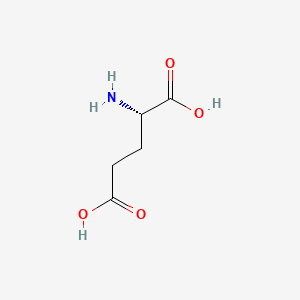m6A-centered Drug Response Information
General Information of the Drug (ID: M6APDG01395)
| Name |
L-glutamic acid
|
||||
|---|---|---|---|---|---|
| Synonyms |
(2S)-2-Aminopentanedioic acid; (S)-(+)-Glutamic acid; (S)-2-Aminopentanedioic acid; (S)-Glutamic acid; 1-Aminopropane-1,3-dicarboxylic acid; 2-Aminoglutaric acid; 2-aminopentanedioic acid; A-Aminoglutaric acid; A-Glutamic acid; Acide glutamique; Acide glutamique [INN-French]; Acido glutamico; Acido glutamico [INN-Spanish]; Acidum glutamicum; Acidum glutamicum [INN-Latin]; Acidum glutaminicum; Aciglut; Alpha-Aminoglutaric acid (VAN); Alpha-Glutamic acid; Alpha-L-Glutamic acid polymer; Alpha-aminoglutaric acid; D-Glutamiensuur; E 620; GLUTAMIC ACID; Glu; Glusate; Glut; Glutacid; Glutamate; Glutamic Acid (L-glutamic acid); Glutamic Acid [USAN:INN]; Glutamic acid (H-3); Glutamic acid (VAN); Glutamic acid polymer; Glutamic acid, L-(7CI,8CI); Glutamic acid, L-, peptides; Glutamicol; Glutamidex; Glutaminic acid; Glutaminic acid (VAN); Glutaminol; Glutaton; Gulutamine; Gulutamine (USP); H-Glu-OH; L-(+)-glutamic acid; L-2-Aminoglutaric acid; L-Glutamic acid (9CI); L-Glutamic acid (JAN); L-Glutamic acid hydrochloride; L-Glutamic acid, homopolymer; L-Glutamic acid, homopolymer (9CI); L-Glutaminic acid; L-Glutaminsaeure; L-a-Aminoglutaric acid; L-alpha-Aminoglutaric acid; L-glu; L-glutamate; POLYGLUTAMIC ACID; Poly(alpha-L-glutamic acid); Poly-L-glutamate; Sodium Glutamate (L-glutamic Acid)
Click to Show/Hide
|
||||
| Status |
Approved
|
||||
| Structure |
 |
||||
| Formula |
C5H9NO4
|
||||
| InChI |
1S/C5H9NO4/c6-3(5(9)10)1-2-4(7)8/h3H,1-2,6H2,(H,7,8)(H,9,10)/t3-/m0/s1
|
||||
| InChIKey |
WHUUTDBJXJRKMK-VKHMYHEASA-N
|
||||
| PubChem CID | |||||
| VARIDT Drug ID | |||||
Target Gene(s) and Their Upstream m6A Regulator, Together with the Effect of Target Gene(s) in Drug Response
The target genes involved in drug-target interaction (such as drug-metabolizing enzymes, drug transporters and therapeutic targets) and drug-mediated cell death signaling (including modulating DNA damage and repair capacity, escaping from drug-induced apoptosis, autophagy, cellular metabolic reprogramming, oncogenic bypass signaling, cell microenvironment, cell stemness, etc.) could be regulated by m6A regulator(s) and affected their corresponding drug response. You can browse detailed information on drug-related target gene(s) mediated by m6A regulators.
Cystine/glutamate transporter (SLC7A11)
Insulin-like growth factor 2 mRNA-binding protein 1 (IGF2BP1)
| In total 1 mechanisms lead to this potential drug response | ||||
| Response Summary | Cystine/glutamate transporter (SLC7A11) is a therapeutic target for L-glutamic acid. The Insulin-like growth factor 2 mRNA-binding protein 1 (IGF2BP1) has potential in affecting the response of L-glutamic acid through regulating the expression of Cystine/glutamate transporter (SLC7A11). | [1], [2] | ||
Methyltransferase-like 14 (METTL14)
| In total 1 mechanisms lead to this potential drug response | ||||
| Response Summary | Cystine/glutamate transporter (SLC7A11) is a therapeutic target for L-glutamic acid. The Methyltransferase-like 14 (METTL14) has potential in affecting the response of L-glutamic acid through regulating the expression of Cystine/glutamate transporter (SLC7A11). | [2], [3] | ||
Methyltransferase-like 3 (METTL3)
| In total 1 mechanisms lead to this potential drug response | ||||
| Response Summary | Cystine/glutamate transporter (SLC7A11) is a therapeutic target for L-glutamic acid. The Methyltransferase-like 3 (METTL3) has potential in affecting the response of L-glutamic acid through regulating the expression of Cystine/glutamate transporter (SLC7A11). | [1], [2] | ||
NF-kappa-B-activating protein (NKAP)
| In total 1 mechanisms lead to this potential drug response | ||||
| Response Summary | Cystine/glutamate transporter (SLC7A11) is a therapeutic target for L-glutamic acid. The NF-kappa-B-activating protein (NKAP) has potential in affecting the response of L-glutamic acid through regulating the expression of Cystine/glutamate transporter (SLC7A11). | [2], [4] | ||
YTH domain-containing protein 2 (YTHDC2)
| In total 1 mechanisms lead to this potential drug response | ||||
| Response Summary | Cystine/glutamate transporter (SLC7A11) is a therapeutic target for L-glutamic acid. The YTH domain-containing protein 2 (YTHDC2) has potential in affecting the response of L-glutamic acid through regulating the expression of Cystine/glutamate transporter (SLC7A11). | [2], [5] | ||
References